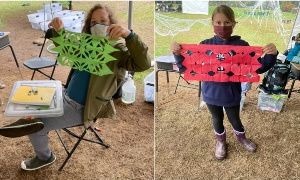Hyla Stories
Día de los Muertos

This week, Señora Ivonne has been asking her students how Día de los Muertos (celebrated on November 2) differs from American Halloween. Here were some 6th grade responses: “They’re celebrating the dead and not scaring people.” “It is more ceremonial.” “It’s almost religious.” 7th and 8th graders analyzed similarities and differences, using a Venn diagram, and 8th graders also strengthened their reading comprehension with an article in Spanish. 6th graders created traditional papel picado decorations, making careful cuts in tissue paper.
As the class practiced vocabulary, students commenting on the sounds — calacas (skull), cempasúchil (marigolds)— Señora Ivonne pointed out that words often have their origin in ancient languages. Día de Los Muertos started from intricate traditions based in Aztec and Mayan civilizations. On this day, families invite spirits and celebrate that their loved ones are near to them. “People talk, share, drink, eat, and smile.” Día de los Muertos is about “closeness,” and the importance of bringing people together. Graveyards fill with people and flowers, both in Mexico and in Ecuador, Ivonne’s heritage. “My ancestors didn’t mourn, they celebrated.”
Understanding and respecting other cultures are among the goals for Spanish studies. Señora Ivonne also wants students “to recognize the transition between indigenous civilizations and the powerful influence of colonization.” Many Spanish-speaking cultures today continue traditions that represent a fusion of ancient cultures combined with Spanish Catholicism. While studying Día de los Muertos, Hyla students are not only learning vocabulary such as esqueleto (skeleton) and pan de muerto (bread of the dead), they are also learning how to understand cultures, values, and many ways of celebrating life.
